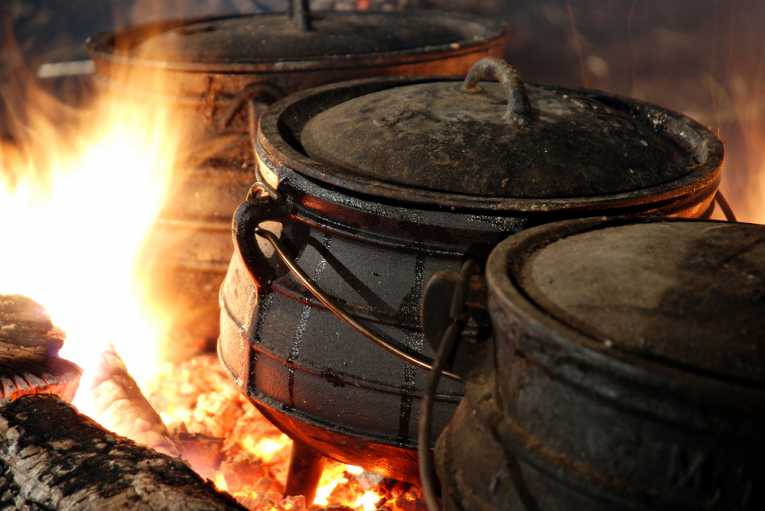Flecks of soot from a smoky open stove in India blacken more than just the roofs of the hut it is smoldering in. Fine particles of such smoke lodge deep in the lungs of women preparing meals, gifting them a dark scourge of ill-health and premature death. That same black soot floats higher into the air, where it helps to change the way clouds form - and so to warm the climate. Some specks may even end up coating ice in the frozen extremes of the planet, dulling their pristine surfaces, and hastening the melt of glaciers and ice-caps.
And recent reports suggest that the weakening monsoon in India, and unprecedented storms in the Arabian Sea, may owe their genesis to the smoggy brown clouds gathered over the Indian sub-continent. For such tiny little particles, soot appears to be having mammoth impacts, and in a host of different ways. But the problem of soot is not one of those tangled and knotted issues that needs an impossibly herculean efforts to sort out. It may be that its dark legacy can be addressed by something as simple as a clean-burning stove.
From cooking to climate change: The problem of the gathering smoggy clouds over many parts of the developing world has been visible for decades. But only recently have all of the implications become apparent. Some of the particles making up the haze come from wildfires; some from coal-burning power stations; some from diesel-fumes, as urban traffic swells. But in many places, and especially in the Indian sub-continent, a large share comes from cooking stoves.
It is thought that up to 3 billion people worldwide still cook over open fires or stoves, filling their homes, and the local atmosphere, with smoke. Maybe 800 million of these people are in India, in both cities and villages. And the sheer number of their cooking fires is helping to build up a 2 mile-thick hazy cloud over much of South Asia.
A study published this week in Nature revealed that this gloomy layer was causing tempestuous knock-ons for people living around the Arabian Sea. Unprecedented storms first struck at Gujurat in India in 1998, then Iran in 2007, and then Pakistan and Oman in 2010. Storms of cyclone strength had not been recorded in these areas before, which made the study's authors sit up, and take note.
'There has been a real uptick in the intensity of tropical cyclones in the Arabian Sea,' said Amato Evan, lead author from the University of Virginia's College of Arts & Sciences. 'We wanted to understand why, and we think we found the reason.' That smoking gun pointed directly to the domestic cooking arrangements of the sub-continent's inhabitants.
The climate scientists think that India's smoky haze has been helping to shade parts of the Arabian sea, reducing the contrasts in temperature between the equator, and the tropics. That, in turn, has slowed the driver of strong winds, which used to shear off the tops of storms in the Arabian Sea, before they got going. As that wind shear has weakened, so the storms have grown.
In their study, the scientists found that models of India's brown clouds produced exactly the same strengthening feature, with more dangerous Arabian Sea cyclones. So man's sooty fingerprints are all over another changing feature of the climate. "We are showing that pollution from human activity - as simple as burning wood or driving a vehicle with a diesel engine - can actually change these massive atmospheric phenomena in a significant way. It underscores the importance of getting a handle on emissions in the region,' said Evan.
Enter, stage right, the clean stove: If soot is causing a multiple of ills, then a solution could be brilliantly simple. Technology to produce heat from traditional fuels, without the soot, already exists - and can be quite simple. With a cooking arrangement that takes the smoke and soot out of the equation, lives could be changed; climate risks could even be averted. But to do that, a clean-breathing replacement for India's and Africa's millennial-old cooking technology needs to leap several hurdles.
It must be cheap enough to be afforded by some of the poorest families on the planet. It needs to to work with locally available fuels, in an efficient manner. It has to be robust and easy to maintain and fix. And above all, it has to cook in a way that traditional fires do. That's a challenge being risen to many different groups, bedded in many different developing world communities.
An exciting example is to be found in Kenya, where local artisans are adapting Western designs - such as the rocket stove - and making them their own. Biochar advocates re:char believe that local is the best way forward for such schemes. They believe that well-meaning technological solutions, imposed from the outside, often fail because not enough attention has been paid to what local people want.
So it seems that the unknotting of at least one of the tangles of environmental woes may be within our collective grasp. While the world wrestles to find a solution for the invisible carbon - CO2 - finding one for that very much more visible carbon - soot - wants for nothing more than a decent stove. A failure to deal with most tractable of problems would leave a very black stain indeed.
Martin Legget writes more climate musings on his blog Wyrd Climate.










